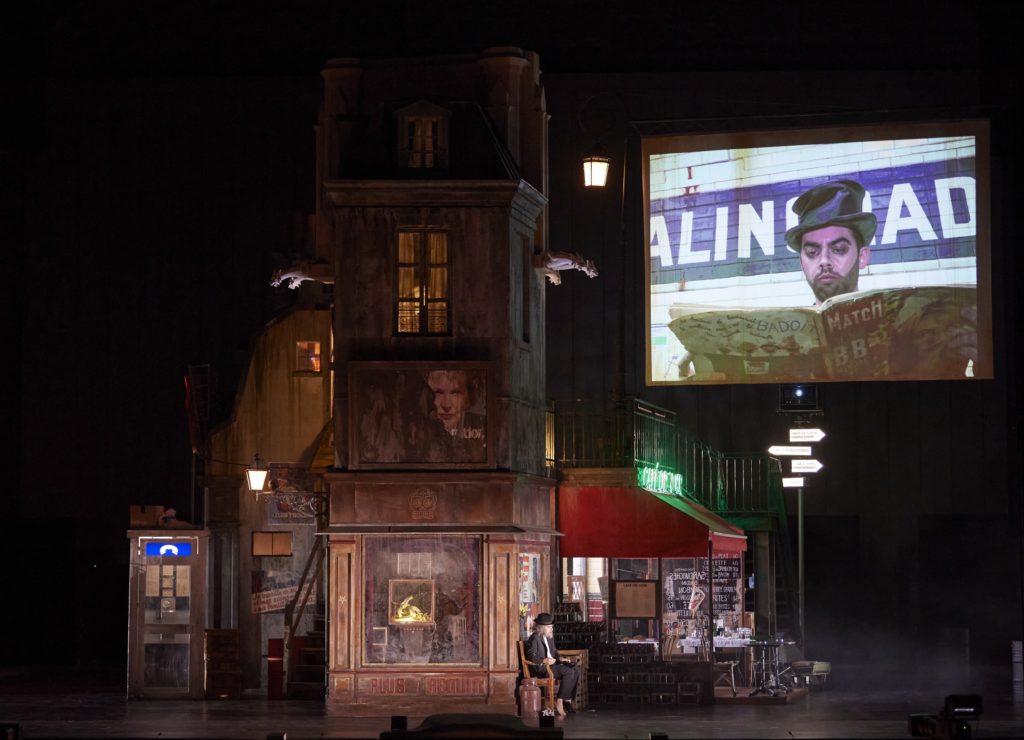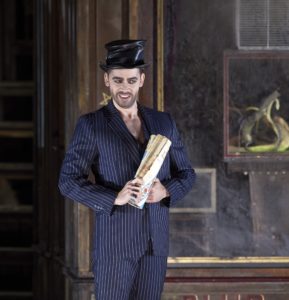In Vienna State Opera’s (2008) production, director Frank Castorf imposes his own radical agenda. Gounod’s Paris of 1859, meets a modern Paris of the 1960s. It reflects the left-wing, radical, revolutionary late-60s. But there’s now a post-colonial reading: ‘from the capitalism and colonialism of Gounod’s time, leading into the current European crises’?! To say the Director ‘adds a new complexity to the work through a multitude of references’ is no understatement. The stage is garish and messy.
Well, from the first notes- the marvellous introduction to Faust’s soliloquy- we needn’t worry about the stage sets. Gounod’s music is seductively powerful, Vienna State Opera orchestra conducted by Bertrand de Billy, exceptional.
The opening is a highlight with the aria ‘Salut chaste et pure’. A grey-haired, stooping figure with a walking stick, the older Faust, looks back bitterly. Alexander Edtbauer, with languishing emotion, in vain he questions his master; sings of the innocent and divine soul of the absent Marguerite. Now he sees nothing, knows nothing. Rien. Oh, darkness when will you take me. He holds up his glass, Oh cup so often filled! He’s standing outside a bar, the neon sign Café-Noir. To the right, almost offstage, the entrance to a Metro station. Does it matter? The aria sweeps us away- Gounod’s music played with such passion- you don’t at first notice the grunge.
Oh come to me, Satan come!…Here at your service! Adam Palkas’s besuited Mephistopheles, his tenor seductively beautiful, is bare-chested, cocky, insolent, fun. Insouciantly donning a top-hat, he swigs from a flask of cognac.Your bidding, you want Fame. Money, Power?- Your hand is trembling.- Faust wants his youth back. Very well what must I do? – Youth is calling; accept the change!- Merveilleux, the pleasures of the young. GIVE IT TO ME! The deal is struck: the Devil will serve Faust until death, then roles reverse.
Video screens (Act2) show scenes of boozing in rowdy Paris bars; soldiers in khaki uniforms. Pouring out of a metro station, a carnival of street girls, outrageous headgear, wild, garishly-colourful outfits. Louche call-girls slide down the banisters of a spiralling staircase. A battle scene montage is showing on a large video screen above. Valentin, (Étienne Dupuis, beautifully sung), I entrust my sister to you, King of Heaven. (Thus he’s pitted fatally against Mephistopheles.) He holds up the Tricolour, and wraps himself in the flag. He must leave his Patrie to war. But the TV monitor shows shocking scenes of battle-weary troops, bathing their bloodied feet.
Outside Café Noir again, the crowd are singing a drunken chorus Vin ou Bière . Mephistopheles joins them to blaspheme. In Mephistopheles’ virtuoso number, ´The Golden Calf Le Veau d’or, he has the human race at his feet, and ‘Satan leads the Dance’. Mephistopheles, showing his malicious side, rules that Sieble will carry no more flowers to Marguerite. (Valentin asks how does he know her name?) Palka’s Mephistopheles in leather waistcoat, fiercely exhibits the devil’s tattoos. Valentin holds up a crucifix. Mephistopheles sneers, challenging him, let’s see if the Lord will protect her.
Where is the beautiful woman you showed me? At first we see Siebel, Marguerite’s protective friend. Margaret Plummer’s powerful mezzo, in skin-tight shimmering black. Marguerite, soprano Rachel Willis-Sorensen, is a fresh-faced French blonde. Under a red Coca-Cola sign, iconic symbol of American capitalism; but the letters are scrambled, in Castorf’s subversive, anti-consumerist vibe. Mephistopheles and Faust creep up. Tell her she’s beautiful, Siebel sings.
John Osborn’s young Faust is now in a fashionably-cut suit, wearing a trendy black t-shirt. Sexier, but doesn’t quite hide his paunch. (Osborn replaced Stephen Costello at short notice.) In Faust’s aria, he’s the romantic idealist, engulfed in love. O, Marguerite, I lie here at your feet. Osborn’s is a lyrical tenor, sensitive and sonorous. He pleads, give shelter to this pure and innocent soul.
In Gounod’s scheme, Marguerite discovers a bouquet and jewel box, her excitement erupting in ‘The Jewel Song’. Here, Siebel stands centre-stage, surrounded by designer-boutique carrier bags. Goodies for Marguerite, who’d like to know the identity of the young man ‘who seems to have a noble air.’ We see Marguerite on the overhead video. Naively, she sings (of Faust) ‘only great lords walk so gracefully. Willis-Sorensen is now curiously opening the bags. In a white dress, Sorensen’s Marguerite is like a 30’s screen goddess, Garbo-like, with her radiant, milky-white complexion. 
Mephistopheles persuades Faust to speak to her again. But at first she beseeches him to go; don’t break Marguerite’s heart. Faust sings piously, ‘this chaste virtue quells his desire.’ She let’s herself be embraced by Faust, in their duet, laisse-moi contempler ton visage. Divine happiness: let’s go! Goaded on by Mephistopheles, they make love. Then video screens of Paris, the iconic sights, Champs-Elysées. But having made her pregnant, he abandons her: the devil’s work.
Back to Café Noir. Sorensen, now in a pink dress, in Marguerite’s aria, all she has left is shame. Il ne revient pas , she knows he’s not coming back. Given birth to Faust’s child, she’s ostracised. But Siebel, appearing with a supermarket trolley, will avenge her. She’ll pray to God for her.
Scene shift to a public square, for Valentin’s return, and the bombastic military march. Siebel leads the Soldier’s Chorus, ‘arresting the nation from its colonialist past, exploiting the indigenous population’. Not in Gounod’s script! Castorf injects his post-colonialist agenda. In La Guerre, Gounod’s terrific Chorus, Vienna State Opera’s excel. Of course, in Castorf, the front-stage is filled with bloodied, decapitated heads. (The soldiers demobbed, Valentin asks, where’s Marguerite.- In Church, praying.)
Faust is manipulated into challenging Valentin, ‘draw the blood of his brother.’ There’s a strange scene of the dying Valentin in the Bar entrance. Valentine is shot, he curses his killer. But Chorus reiterate, May the Lord welcome his soul and forgive the sinner. To a familiar riff, Mephistopheles summons spirits of evil. – Faust: Where are we?- In my empire. – My blood freezes!
Act 5, of Gounod’s time, is frankly a drag for religious sceptics: all about the battle to save Marguerite’s soul. There are flashbacks of Marguerite praying in church. Now hell is claiming her. We see in a dream sequence Mephistopheles, who’s violated the sanctity of the church. God no longer protects you, he taunts her. To a drum roll the stage rotates to show the underbelly of Paris: the dispossessed, barbed wire, hands reaching out. Marguerite is trying to clean up blood-red graffiti.
The final scene is more confused, a surrealist world of spirits. They’re building the scaffold. Marguerite, in her cell, ‘sweet creature in the depths of prison’; despair drove her into madness, she killed the child. – Faust go away!! Mephistopheles’ hand ‘frees her’. She collapses. In a tug-of-war for her soul, Faust tries to abscond with her before daybreak. She will stay. She sees the devil is waiting there. But she is resurrected. Gounod, the experienced church musician, pulls out all the stops; organ and orchestral fireworks. Marguerite is saved from eternal damnation. Tremendous playing from de Billy’s Orchestra. Yet I couldn’t wait for the final red curtain.
Castorf’s ‘concept’ wasn’t so radical after all. Importantly, Gounod’s score is not obviously expurgated. Video screens, hardly new, after 30 years, commonplace in theatre. Only the 1960’s agit-prop, radical-left slogans, seem dated. But in Castorf’s ‘post-colonial revisionism’, where -in the street scenes and choruses- is the ethnic diversity on stage? PR. 6.11.2021
Photos © Juan Diego Florez as Faust, Adam Palka, Mephistopheles; Adam Palka, Mephistopheles; Rachel Willis-Sorensen as Marguerite
© Michael Pöhn/ Wiener Staatsoper.


